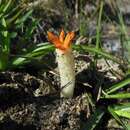en
names in breadcrumbs


Lysurus cruciatus, auch als „Fingerpilz“ bekannt, ist eine Pilzart aus der Familie der Stinkmorchelverwandten (Phallaceae) und gehört zur Gattung Lysurus.
Aus einem bis zu 4 cm großen Hexenei entwickelt sich ein poröses, weißes bis cremefarbenes Receptaculum, welches von 5 bis 7 kurzen Armen gekrönt wird. Diese werden vom Stiel durch eine ringförmige, schwach entwickelte Leiste abgegrenzt. Die Arme sind auf der Innenseite querrunzelig und werden auf der Außenseite von einer Längsfurche durchzogen. Ihre Farbe wird unterschiedlich beschrieben: Sie reicht von weißlich und gelbbräunlich bis orange. Anfangs sind die Arme zu einer kegelförmigen Spitze zusammengeschlossen und spreizen sich nach Abfließen der bräunlichen, übelriechenden Gleba auseinander. Genau wie bei Clathrus archeri (und anderen Vertretern der Stinkmorchelartigen) werden die Sporen von Insekten (vor allem von Aasfliegen) verbreitet, die die Gleba fressen.
Lysurus cruciatus war ursprünglich in Südamerika, Südafrika und Australien beheimatet. Darüber hinaus konnte die Art auch in den Vereinigten Staaten (vor allem in Kalifornien) nachgewiesen werden, wo sie wahrscheinlich eingeführt wurde. Auch in Westasien und Europa (England, Niederlande, Portugal und Schweden) wurde Lysurus cruciatus höchstwahrscheinlich eingeführt. In Deutschland wurde Lysurus cruciatus bisher nur in Ludwigslust, Leipzig-Paunsdorf, Luckau und in Schulzenhof bei Gransee gefunden. Im Gegensatz zu anderen Neomyceten, wie Clathrus archeri, konnte sich die Art in Deutschland bisher jedoch nicht etablieren und ist ein seltener Exot geblieben.
Bei Lysurus cruciatus handelt es sich um einen Saprobionten, der einzeln oder in Gruppen am Boden, auf Grasflächen, in Gärten, auf Totholz und auf Heuballen wächst.
Lysurus cruciatus gilt als ungenießbar.
Lysurus cruciatus, auch als „Fingerpilz“ bekannt, ist eine Pilzart aus der Familie der Stinkmorchelverwandten (Phallaceae) und gehört zur Gattung Lysurus.
Lysurus cruciatus or the lizard's-claw stinkhorn[4] is a species of fungus in the stinkhorn family. It was first described scientifically in 1845 by French botanists François Mathias René Leprieur and Camille Montagne as Aserophallus cruciatus. German mycologist Paul Christoph Hennings transferred it to the genus Lysurus in 1902.[3] Its fruit bodies feature a white, cylindrical tube supporting a cluster of hollow, reddish pointed arms whose surface is covered with foul-smelling spore mass, or gleba. The gleba is brownish to greenish in color, and contains spores with dimensions of 3–4 by 1.5–2 µm.[5]
In 1901, this mushroom was rediscovered in Inanda, Natal.[6] This "new" find was named L. Woodii, which was later corrected to be the previously discovered L. Cruciatus.[7]
Lysurus cruciatus or the lizard's-claw stinkhorn is a species of fungus in the stinkhorn family. It was first described scientifically in 1845 by French botanists François Mathias René Leprieur and Camille Montagne as Aserophallus cruciatus. German mycologist Paul Christoph Hennings transferred it to the genus Lysurus in 1902. Its fruit bodies feature a white, cylindrical tube supporting a cluster of hollow, reddish pointed arms whose surface is covered with foul-smelling spore mass, or gleba. The gleba is brownish to greenish in color, and contains spores with dimensions of 3–4 by 1.5–2 µm.
In 1901, this mushroom was rediscovered in Inanda, Natal. This "new" find was named L. Woodii, which was later corrected to be the previously discovered L. Cruciatus.
Lysurus cruciatus je grzib[5], co go nojprzōd ôpisoł Lepr. & Mont., a terŏźnõ nazwã doł mu Henn. 1902. Lysurus cruciatus nŏleży do zorty Lysurus i familije Phallaceae.[6][7][8]
Lysurus cruciatus je grzib, co go nojprzōd ôpisoł Lepr. & Mont., a terŏźnõ nazwã doł mu Henn. 1902. Lysurus cruciatus nŏleży do zorty Lysurus i familije Phallaceae.